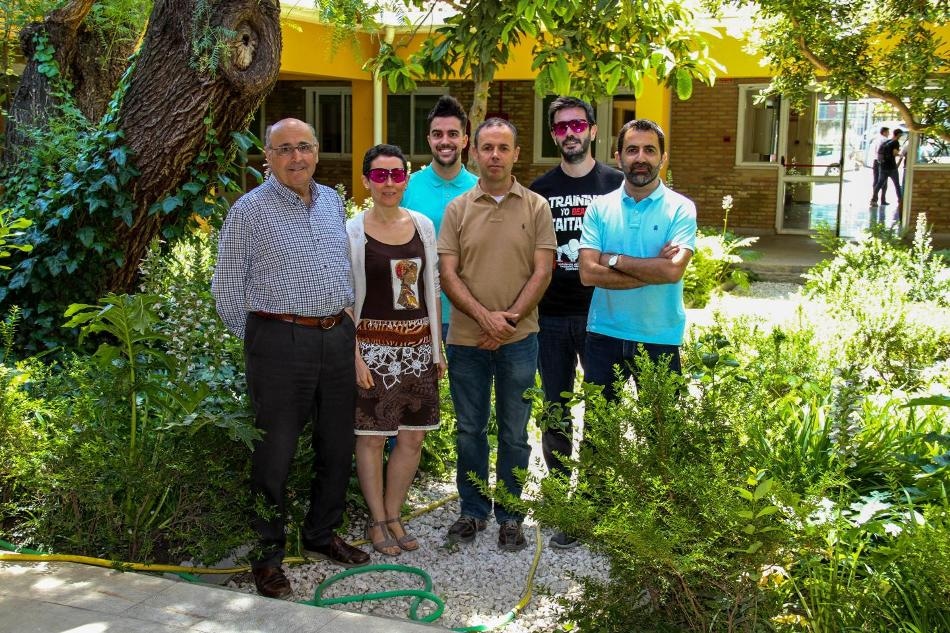 By Megan DaviesJun 18 2019
By Megan DaviesJun 18 2019Among the European population, 0.5% of females and 8% of males (i.e., nearly 22 million people in the European Union) suffer from a congenital anomaly in their color vision, which is generally called color-blindness.
 The research group at the UGR’s Department of Optics (Faculty of Science) comprises doctors Miguel Ángel Martínez Domingo, Luis Gómez Robledo, Eva Valero Benito, Rafael Huertas Roa, Javier Hernández Andrés and Enrique Hita Villaverde and student Silvia Ezpeleta Gascón. (Image credit: University of Granada)
The research group at the UGR’s Department of Optics (Faculty of Science) comprises doctors Miguel Ángel Martínez Domingo, Luis Gómez Robledo, Eva Valero Benito, Rafael Huertas Roa, Javier Hernández Andrés and Enrique Hita Villaverde and student Silvia Ezpeleta Gascón. (Image credit: University of Granada)
Despite the fact that genetic therapies have been tested successfully on primates and mice, until now, there has been no effective treatment for color-blindness.
At present, there are a number of “active” and “passive” aids available on the market that claim to enhance color-defective vision among color-blind people, the assistance of some of which are debatable. The so-called “active” aids use image-processing algorithms to alter the color of images to improve the contrast between colors that, otherwise, would be indistinguishable for the user.
“Passive” aids, which are based on color filters, can also be used as contact lenses or tinted glasses, even with their respective optometric compensation. Of the passive aids available in the market, the glasses marketed by the US companies VINO and EnChroma are specifically superior due to their media profile and novelty.
In 2018, scientists from the University of Granada (UGR) investigated the performance of EnChroma’s glasses (model Cx-65) and concluded that they do not enhance the results of color-blind participants following a range of diagnostic tests. Moreover, they did not allow the color-blind participants to have a color vision comparable to that of normal observers. The published outcomes of this study had larger social implications.
The UGR scientists later analyzed some of the viral videos related to the O2Amp “Oxy-Iso” glasses. The videos depicted color-blind users crying with joy upon using the product for the first time. After learning about VINO’s advertising claims for products such as these, the UGR researchers chose to perform an in-depth study of the effectiveness of these glasses.
Their fact-finding study was motivated by a strong belief that researchers are morally connected to the society that calls on them to find and disprove—based on rigorous experiments—any false information disseminated by companies. In this scenario, the information from these companies targeting color-blind people could lead to false hopes, for instance, the suggestion that the product would allow consumers to see new colors or even to rectify their color-blindness totally.
Despite that the O2Amp “Oxy-Iso” glasses from VINO Optics were originally created for medical professionals to enhance the contrast of the veins under the skin, the inventors claim the technology assists color-blind people with red-green deficiency (called deutans and protans).
Currently (June 2019), the company website claims, “Our Color Blindness technology corrects red-green color deficiency, based on a scientific understanding of what color vision is for.” It also claims the technology “does more than simply allow you to pass the Ishihara test,” which is one of the basic and standard tests for finding out whether a person is color-blind.
The scientists used a dual approach to evaluate the efficiency of these glasses. Firstly, they assessed the vision of 52 color-blind people, with and without the VINO glasses, through different tests generally used to evaluate color vision: the Ishihara color test (recognition test) mentioned above and the Farnsworth-Munsell (FM) 100 hue test (arrangement test). In addition, they added a color-naming test that is based on the X-Rite color chart.
The second approach was to replicate the glasses’ effect on observers presenting varying degrees of simulated color-blindness using the spectral transmittance of the VINO lenses. This allowed the researchers to evaluate the variations they generated in the appearance of colors, as perceived by different people. The study was completed by comparing the outcomes with those acquired by the EnChroma Cx-65 glasses.
The VINO O2Amp “Oxy-Iso” glasses’ low-level transmittance in the intermediate region of the spectrum brought about a considerable change in the appearance of the color, specifically in the chroma attribute. This change enables certain color-blind people, specifically deutans, to pass simple recognition tests, like the Ishihara, but not the more extensive arrangement tests, like the FM100.
These outcomes, in conjunction with those acquired through simulations using an innovative “Daltonization” algorithm, revealed that these glasses do not enhance the color vision of color-blind subjects to such an extent that they can perceive color similar to people with normal vision. Yet, they might enable certain tasks that necessitate color discrimination.
As a matter of fact, these glasses can specifically help deutans in certain tasks, for instance, assisting them to differentiate certain colors that can lead to confusion (at the risk of confusing others that they earlier perceived differently). Moreover, the glasses can be helpful in particular applications (for example, enhancing the contrast of veins under the skin), quite similar to other color filters used in activities like shooting or hunting, or in low-vision contexts.
In a paper published recently in the Optics Express journal (one of the world-renowned publications in the optics field, with among the highest impact indices), the UGR scientists conclude: “Our results support the hypothesis that glasses with filters are unable to effectively resolve the problems related to colour vision deficiency.”
In spite of the efforts of this research group, a number of alternatives are still available on the market that are based on the use of colored filters. Even these use analogous marketing strategies for product promotion, based on the concept of realizing normal color vision among color-blind people.
The research team from the UGR’s Department of Optics (Faculty of Science) includes doctors Miguel Ángel Martínez Domingo, Luis Gómez Robledo, Eva Valero Benito, Rafael Huertas Roa, Javier Hernández Andrés, and Enrique Hita Villaverde and student Silvia Ezpeleta Gascón.